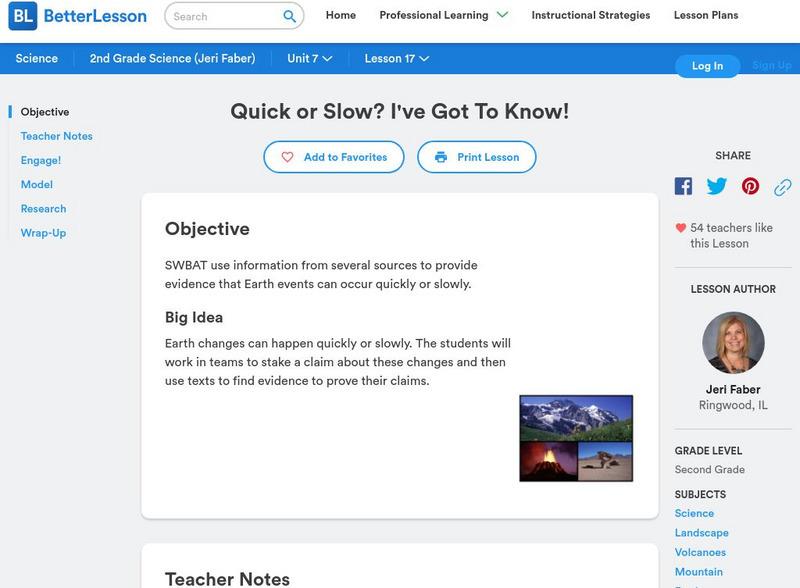Curated OER
Help! I'm Under Too Much Pressure!
Students play with a ping pong ball sized piece of modeling clay observing what happens to the clay as they play with it and write their observations in their notebooks. They share the results of their observations introducing the term...
Curated OER
Rock Eaters of the Gulf of Alaska
Students compare and contrast the processes of photosynthesis and chemosynthesis. They identify and describe sources of energy used by various organisms for chemosynthesis.
Curated OER
The Planet Wakyabi
Fifth graders explain how organisms' specialized structures and variations work with the environment to help them survive.
Curated OER
Franklin Mountains
Fifth graders examine photographs of the eastern and western Franklin Mountains. As a class, they discuss what is shown and the different colored rocks and the orientation of the layers. In groups, they are given clay of two different...
Curated OER
Social Studies: When Diseases become Epidemic!
Student participate in oral discussions to be able to define epidemic and identify 3 instances in history in which epidemics occurred. They are introduced to the quarter theme, disease. Students identify disease as a crucial dictator...
Curated OER
Aids to Communication
Pupils define an aid to communication, give an example of an aid to communication, and develop an aid to communication. Students also describe the aid's use and applicability
Curated OER
Interpreting Satellite Images
Students identify differences between photography and satellite imagery space.
Curated OER
About to Explode
Students explore Mount St. Helens' quiet eruption of 2004-2005. They examine different types of eruptions and then present creative first-hand accounts of different volcanic eruptions in history.
Curated OER
Glacier Climbing
Pupils discuss glaciers and the current distribution of glaciers around the Earth. They create simulated glaciers using cornstarch, shoeboxes, water, and pebbles.
Curated OER
Research Report on Earth Science Topics
Sixth graders are given a variety of Earth Science topics which be covered during the year. They select one of their choices to research and work in class and at home to meet the guidelines for their report.
Curated OER
Math: Counting on Others
Pupils use counting skills to decide who wins the Classroom Winter Games. They use numeral writing and tally marks to keep score. Students have an opportunity to pretend they are competing for medals in the Winter Games while using...
Curated OER
Time Line Of Chinese And Japanese Art
Pupils create individual time lines placing various works of Asian art into chronological order. The information gathered is used to create one class time line for display.
Curated OER
Fallout!
Students plot the locations of fallout from two disasters that polluted much of the world's air. They plot the ash fallout from the 1980 Mt. St. Helen's eruption to see what the wind patterns in the United States look like overall. Next...
Curated OER
What's Making It Look So Brown Outside?
Ninth graders analyze cars and particulate matter in the atmosphere. They analyze results of particulate pollutants and identify which vehicle gives off more particulates. They identify sources of particulate matter and relate to...
Curated OER
Natural Hazards
Pupils evaluate the hazards of naturally occurring events. After watching a video concerning safety hazards, students work in groups to discuss the safety issues involved in taking a trip to a mountainous region. Recommendations are...
Curated OER
How Green Are We?
Students identify and interpret the importance of energy efficiency in connection with air pollution. They communicate with families and peers about ways to more effectively contribute to the reduction of air pollution. Finally,...
Curated OER
Breaking News English: Al-Qaeda Warns of More Attacks
In this English worksheet, students read "Al-Qaeda Warns of More Attacks," and then respond to 47 fill in the blank, 7 short answer, 20 matching, and 8 true or false questions about the selection.
Curated OER
Life of An Island
Students identify the steps in the life cycle of an island. They label islands in the correct stage of their life cycle and illustrate the process themselves. They also review the concept of plate tectonics.
Curated OER
Global Warming Is Human Made
In this environmental awareness activity, students read an article about the causes of global warming. Students then answer seven true or false questions, 10 10 synonym matching questions, and ten phrase matching questions based on the...
Teachnology
Teachnology: Volcano Teaching Theme
For any educator planning a teaching unit/theme on volcanoes, this is the place for you! Links to a myriad of lesson plans, worksheets, bulletin board ideas, interactive sites, WebQuests, and much more are all found on this site.
Oregon State University
Volcano World: Mount St. Helens
Contains images, movies, panoramas, information, and history of the Mount St. Helens eruption (1980) as well information and images of the current state of the volcano.
Sophia Learning
Sophia: Volcanoes: Lesson 2
This lesson will provide models or diagrams that explain how volcanic eruptions occur, and discuss their impact on living things. It is 2 of 5 in the series titled "Volcanoes."
US Geological Survey
U.s. Geological Survey: Volcanoes
Six-part interdisciplinary teaching packet. Through the story of the 1980 eruption of Mount St. Helens, students will answer fundamental questions about volcanoes. By learning about volcanoes, students will understand that the Earth...
Better Lesson
Better Lesson: Quick or Slow? I've Got to Know!
Earth changes can happen quickly or slowly. The students will work in teams to stake a claim about these changes and then use texts to find evidence to prove their claims. Included in this lesson are video clips of the class, a list of...






















